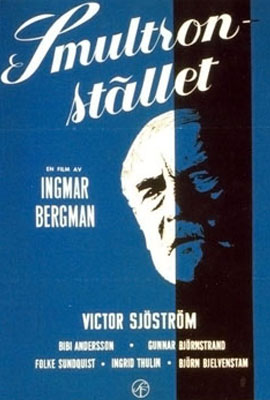
(1957)
directed by Ingmar Bergman
“Wild Strawberries” opens with a famously surreal dream sequence. Professor Isak Borg is on a walk and arrives at a house with boarded up windows in the old quarter of Stockholm. He sees a clock with no hands. He checks his pocket watch and sees that it also has no hands. A horse drawn hearse is approaching. One of the hearse’s wheels gets caught on a lamppost, detaches, and rolls down the street. The coffin slides to the ground and falls open. Professor Borg sees that he is the corpse. The outstretched hand of the corpse tries to pull him inside the coffin. The screen goes black. Cut to Professor Borg shaking his head and awakening.
Ingmar Bergman’s magnificent film tells the story of Professor Isak Borg, an elderly, distinguished medical doctor and researcher, who travels by automobile from Stockholm to Lund with his pregnant daughter-in-law, Marianne, in order to receive an honorary degree. They drive through the beautiful Swedish countryside and pick-up three youthful hitchhikers. The beauty of the countryside and the presence of the lively young hitchhikers set off a flood of memories for the old professor.
The Swedish title of the film literally translates as “strawberry patch” which is idiom for picking happy moments from one’s past to remember. The beauty of the Swedish countryside reminds the professor of his childhood and one of the hitchhikers, a young woman named Sara, reminds him of his childhood love, a young woman also named Sara. Both Saras are played in the film by Bibi Andersson. Through a series of dreams and flashbacks, Professor Borg recalls the events in his life. As the past is recalled, each stage of life, from childhood to old age, is vividly portrayed.
The first flashback takes the professor back to his childhood summer home. The family is preparing for Uncle Aron’s birthday breakfast. Sara, Isak’s childhood love, is picking wild strawberries as a gift for Uncle Aron. Isak’s handsome, dashing brother, Sigfrid, finds Sara in the strawberry patch and begins flirting with her. Sara tells Sigfrid that Isak is nicer, kinder, and more high minded. Nevertheless, Sara is attracted to Sigfrid. She is mortified to find herself kissing Sigfrid even though she is engaged to Isak. The wild strawberries she has just picked for Uncle Aron are spilled on the ground. The breakfast scene which follows perfectly captures an old-fashioned family gathering. The sun is shining and a magnificent meal is spread on the table. The young people are lively and boisterous, reminding us of the young hitchhikers. During breakfast, Sara is teased about the stolen kiss with Sigfrid.
Later in the film, the professor dozes off in the car after lunch and returns for a second time to his childhood summer home. This time the sky is dark and filled with screeching birds. Twisted tree limbs are silhouetted against the sky. Sara is seated in the same strawberry patch but seems older. She forces the professor to look at his face in the mirror she holds up to him and tells him she is going to marry Sigfrid. In the first dream, Sara is childish and vulnerable. In the second dream, she is distant and hostile.
The old professor is haunted by these upsetting dreams and by the earlier revelation by his daughter-in-law that she and her husband (the professor’s son Ewald) consider him to be cold and egotistical. He comes to the conclusion that he has been admired but not loved by the people in his life. There is a Kafkaesque trial in the middle of the film in which the professor is accused of the crime of “guilt.” Look closely and you will see that Sara, the professor’s childhood love, is sitting in the jury box. No verdict is rendered. Perhaps the film’s ending is a verdict of sorts.
Victor Sjostrom, who plays the part of the old professor, actually was approaching the end of his life. He died three years after the film was released at the age of eighty. Sjostrom, one of the great actors and directors of the Swedish silent film era, is warm and sensitive in the role of the old professor. On the one hand, the daughter-in-law, Marianne, has told us that Professor Borg is cold and egotistical. On the other hand, the actor who plays the part of Professor Borg radiates warmth and sensitivity. What are we to make of this apparent contradiction? What is the professor’s true character? These questions set the stage for one of the most satisfying endings in all of cinema.
The film’s ending includes a series of heartfelt events that tell us that the professor is a warm and generous man who is much loved by the people in his life. Together, these events provide a sense of closure for the old professor as he approaches the end of his life. The professor’s life has been eventful and productive despite the devastating loss of Sara’s love.
The film’s ending includes three reconciliations: Professor Borg with his housekeeper; Professor Borg with Marianne, his daughter-in-law; and Marianne with her husband, Ewald. Next, we witness the award ceremony with its solemn procession and praise of the professor’s achievements. The hitchhikers’ utterly delightful nighttime serenade expresses their warm regard for the professor. Finally, in the dream sequence that closes the film, the professor returns once again to the grounds of his childhood summer home. Sara takes his hand and guides him to a spot where he can see his parents sitting next to a lake with their fishing rods. They turn in the sunshine and wave to him.